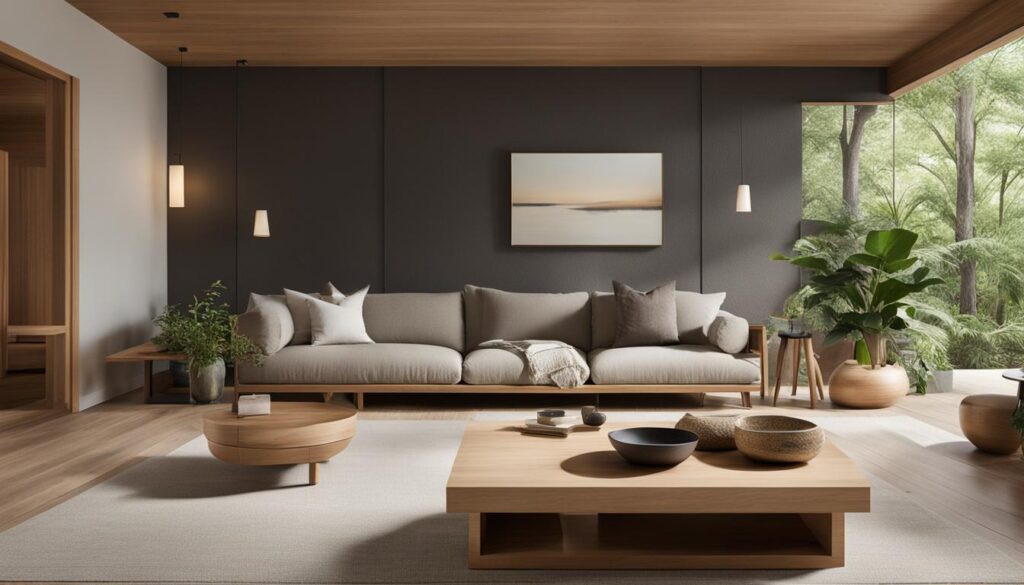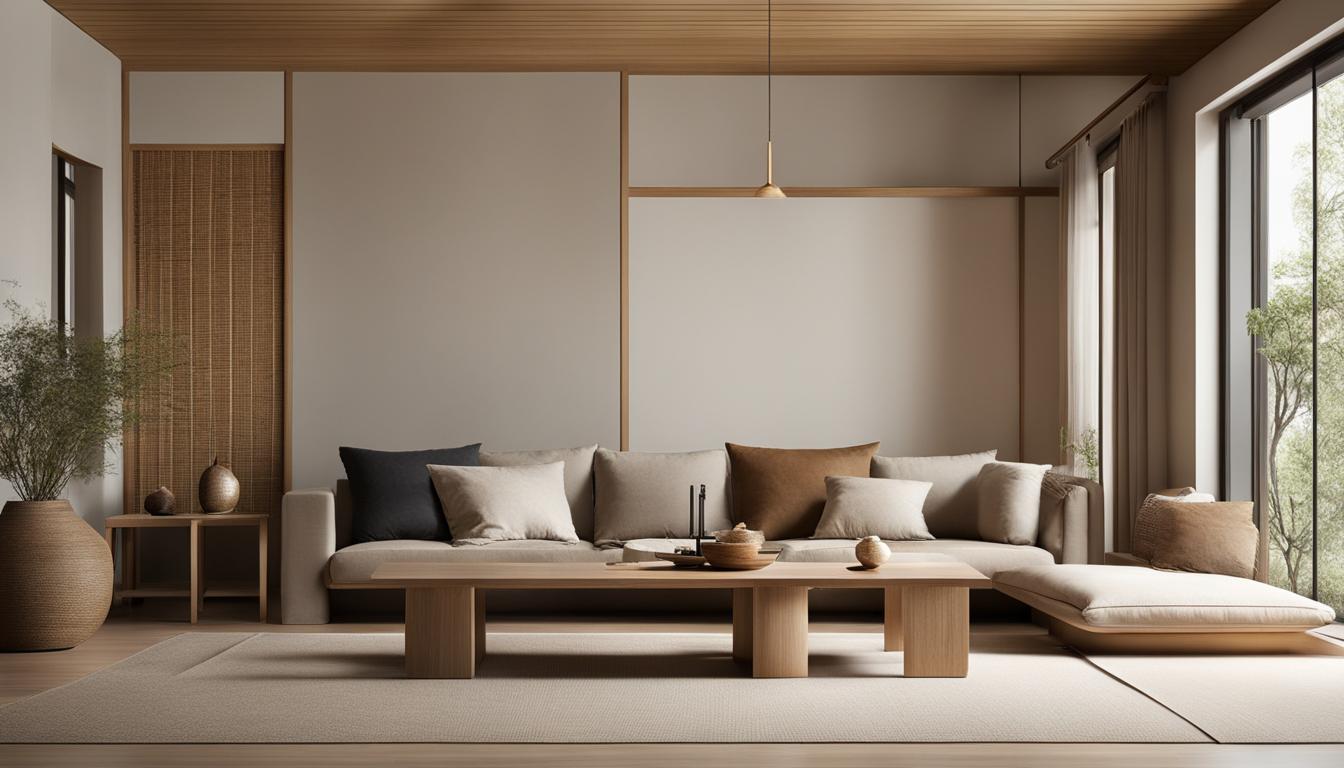Welcome to the world of Japandi style, where modern minimalism meets the timeless elegance of Japanese interior design and Scandinavian fashion.
This fusion decor embraces natural materials, a neutral color palette, and the principles of simplicity and functionality. By incorporating Japandi into your home, you can create a serene and stylish space.
Key Takeaways:
- Japandi style combines Japanese minimalism and Scandinavian functionality.
- It emphasizes simplicity, natural elements, and craftsmanship.
- The color palette is typically muted and earthy.
- Using natural materials like wood and stone adds warmth to the space.
- Japandi style creates a calm and clutter-free environment.
What is Japandi Style?
Japandi style is a unique fusion of Japanese minimalism and Scandinavian functionality. It embodies both design philosophies’ calm and clutter-free principles to create a harmonious living environment.
With its emphasis on simplicity and natural elements, the Japandi style offers a serene and calming atmosphere in your home.
In the Japandi style, clean lines and minimalistic aesthetics are combined with practicality and functionality.
The color palette often features muted tones and earthy hues, which create a soothing ambiance. Natural materials such as wood and stone add warmth and texture to the space, further enhancing the connection with nature.
By embracing Japandi style, you can transform your home into a sanctuary that promotes tranquility and well-being. The blend of Japanese minimalism and Scandinavian functionality creates a balanced and peaceful atmosphere where you can find solace from the chaos of everyday life.
The Essence of Japandi Style

Japandi style is characterized by its focus on simplicity, natural elements, and craftsmanship. This aesthetic embraces a minimalist color palette with muted tones and earthy hues, creating a serene and harmonious atmosphere in your home.
In Japandi style, natural materials such as wood, bamboo, and stone play a vital role. These materials add warmth and texture to the space and strongly connect with nature. Clean lines and organic shapes are incorporated into the furniture and decor, enhancing the overall aesthetic and creating balance and tranquility.
Key Elements of Japandi Style
- Simplicity: Japandi style follows the principle of “less is more,” emphasizing clean lines and minimal clutter. This simplicity allows for a visually uncluttered and calming environment.
- Natural Elements: Using natural materials like wood, bamboo, and stone brings a touch of nature indoors and evokes a sense of serenity.
- Craftsmanship: Japandi style values the art of craftsmanship, showcasing beautifully crafted furniture and decor items that add a sense of refinement to the space.
- Minimalist Color Palette: The color palette of Japandi style is typically minimalist, featuring muted tones and earthy hues that contribute to the overall serene ambiance.
- Clean Lines and Organic Shapes: Furniture and decor in Japandi style have clean lines and organic shapes, creating a cohesive and harmonious aesthetic.
By embracing the essence of Japandi style in your home, you can create a space that is not only visually appealing but also promotes relaxation, mindfulness, and a connection with nature. The blend of simplicity, natural elements, and craftsmanship in Japandi style offers a timeless and elegant approach to interior design.
The Rise of Japandi Style

Over the past few years, Japandi style has gained immense popularity among homeowners and interior design enthusiasts. Combining Japanese Zen philosophy’s timeless appeal with Scandinavian design’s practicality, Japandi style creates a balanced and calming living environment.
The peaceful atmosphere that Japandi style brings to a space is one of the key reasons for its popularity. Inspired by the serenity of Japanese interiors, Japandi style focuses on creating a clutter-free and harmonious atmosphere that promotes relaxation and well-being.
By incorporating elements of Scandinavian practicality, such as functional furniture and clever storage solutions, Japandi style offers a balanced approach to design.
Another factor contributing to the popularity of Japandi style is its ability to create a timeless and enduring aesthetic. With its emphasis on simplicity, clean lines, and natural materials, Japandi style transcends transient design trends, making it a sustainable choice for those seeking a long-lasting and elegant interior.
The Japanese Zen Philosophy and Scandinavian Practicality
- The Japanese Zen Philosophy: Japandi style draws inspiration from the Japanese concept of Zen, which emphasizes simplicity, mindfulness, and a connection with nature. This philosophy is reflected in the clean lines, minimalistic color palette, and use of natural materials in Japandi interiors.
- Scandinavian Practicality: The Scandinavian influence in Japandi style brings practicality and functionality to the forefront. Scandinavian design values efficient use of space, functional furniture, and clever storage solutions seamlessly incorporated into the Japandi aesthetic.
In conclusion, the rise of Japandi style can be attributed to its popularity among those seeking a peaceful and harmonious living environment. Combining Japanese Zen philosophy with Scandinavian practicality, Japandi style creates a timeless and balanced aesthetic that promotes relaxation and well-being.
Embracing Japandi style in your home can bring tranquility and serenity to your living space.
Benefits of Japandi Style

Adopting Japandi style in your home can bring numerous benefits. The minimalistic approach promotes decluttering and reduces visual noise, allowing for a more relaxing and mindful living space. By simplifying your surroundings and embracing a less-is-more philosophy, you can create an environment that promotes a sense of calm and tranquility.
Japandi style also encourages a connection with nature. Using natural materials such as wood, bamboo, and stone brings a touch of the outdoors inside, creating a soothing ambiance. Incorporating elements of nature in your home can positively impact your well-being, helping to reduce stress and promote relaxation.
Benefits of Japandi Style:
- Minimalistic approach promotes decluttering
- Reduces visual noise, creating a more relaxing space
- Connects you with nature through the use of natural materials
- Creates a soothing ambiance for enhanced well-being
Furthermore, Japandi style encourages a mindful and intentional approach to design. You can create a harmonious and balanced environment by carefully selecting each element in your space. This focus on simplicity and functionality allows you to prioritize what truly matters, fostering a sense of clarity and peace.
Overall, embracing Japandi style in your home can transform your living space into a sanctuary of relaxation and mindfulness. By incorporating a minimalistic approach, decluttering, reducing visual noise, and connecting with nature, you can create a soothing ambiance that enhances your well-being and promotes a sense of tranquility.
Conclusion
The Japandi aesthetic is a fusion of simplicity and elegance that creates a serene and calming atmosphere in your home. By incorporating the principles of Japanese minimalism and Scandinavian functionality, Japandi style offers a timeless appeal that resonates with homeowners seeking a harmonious living environment.
Embracing the Japandi aesthetic brings numerous benefits. The clean lines, natural materials, and muted color palette promote a sense of tranquility and mindfulness. Decluttering your space and reducing visual noise creates a more relaxing and visually pleasing home.
Furthermore, Japandi style connects you with nature through earthy hues and organic shapes. Incorporating natural materials like wood and stone adds warmth and texture to your surroundings, creating a soothing ambiance that enhances your overall well-being.
With its fusion of simplicity and elegance, Japandi style offers a unique interior design approach that is visually appealing and conducive to a balanced and calming living environment. By embracing Japandi style, you can create a space that promotes relaxation, mindfulness, and a sense of tranquility for years to come.

